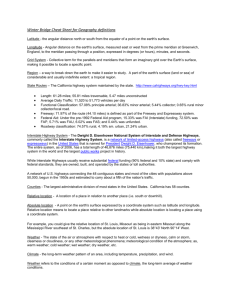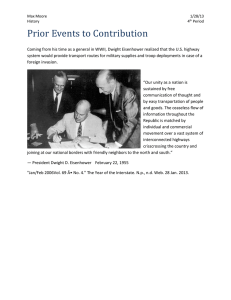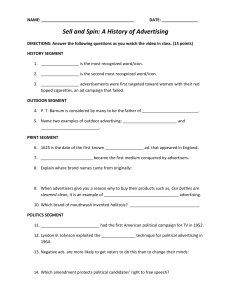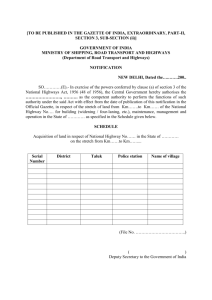AGREEMENT FOR CARRYING OUT NATIONAL POLICY RELATIVE TO
advertisement
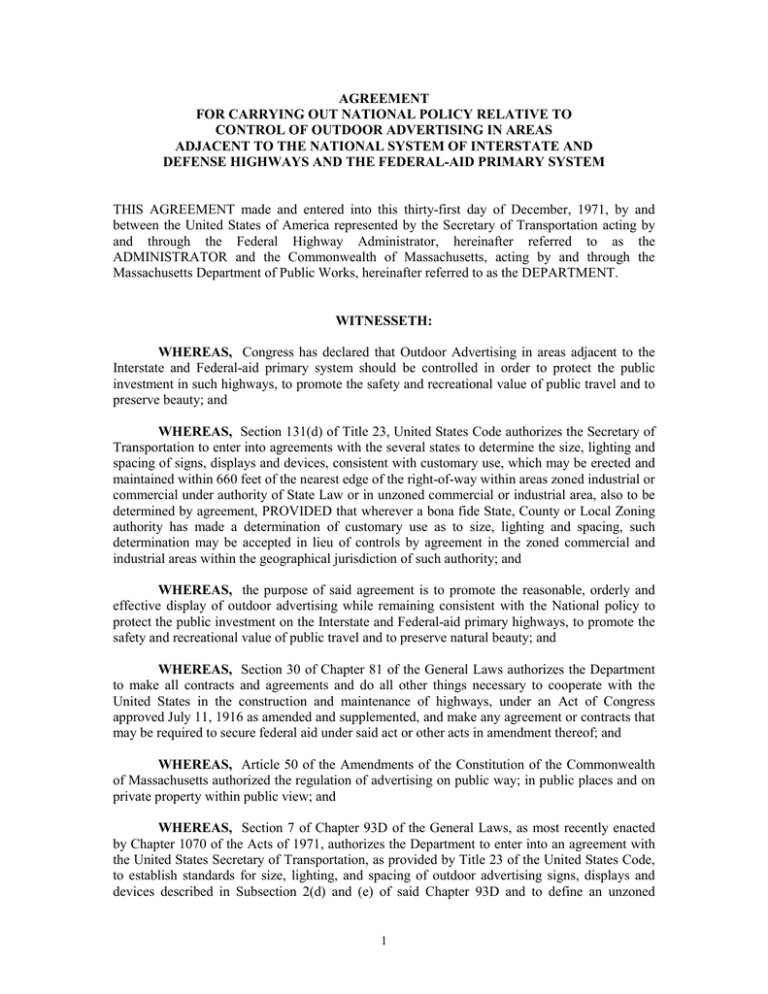
AGREEMENT FOR CARRYING OUT NATIONAL POLICY RELATIVE TO CONTROL OF OUTDOOR ADVERTISING IN AREAS ADJACENT TO THE NATIONAL SYSTEM OF INTERSTATE AND DEFENSE HIGHWAYS AND THE FEDERAL-AID PRIMARY SYSTEM THIS AGREEMENT made and entered into this thirty-first day of December, 1971, by and between the United States of America represented by the Secretary of Transportation acting by and through the Federal Highway Administrator, hereinafter referred to as the ADMINISTRATOR and the Commonwealth of Massachusetts, acting by and through the Massachusetts Department of Public Works, hereinafter referred to as the DEPARTMENT. WITNESSETH: WHEREAS, Congress has declared that Outdoor Advertising in areas adjacent to the Interstate and Federal-aid primary system should be controlled in order to protect the public investment in such highways, to promote the safety and recreational value of public travel and to preserve beauty; and WHEREAS, Section 131(d) of Title 23, United States Code authorizes the Secretary of Transportation to enter into agreements with the several states to determine the size, lighting and spacing of signs, displays and devices, consistent with customary use, which may be erected and maintained within 660 feet of the nearest edge of the right-of-way within areas zoned industrial or commercial under authority of State Law or in unzoned commercial or industrial area, also to be determined by agreement, PROVIDED that wherever a bona fide State, County or Local Zoning authority has made a determination of customary use as to size, lighting and spacing, such determination may be accepted in lieu of controls by agreement in the zoned commercial and industrial areas within the geographical jurisdiction of such authority; and WHEREAS, the purpose of said agreement is to promote the reasonable, orderly and effective display of outdoor advertising while remaining consistent with the National policy to protect the public investment on the Interstate and Federal-aid primary highways, to promote the safety and recreational value of public travel and to preserve natural beauty; and WHEREAS, Section 30 of Chapter 81 of the General Laws authorizes the Department to make all contracts and agreements and do all other things necessary to cooperate with the United States in the construction and maintenance of highways, under an Act of Congress approved July 11, 1916 as amended and supplemented, and make any agreement or contracts that may be required to secure federal aid under said act or other acts in amendment thereof; and WHEREAS, Article 50 of the Amendments of the Constitution of the Commonwealth of Massachusetts authorized the regulation of advertising on public way; in public places and on private property within public view; and WHEREAS, Section 7 of Chapter 93D of the General Laws, as most recently enacted by Chapter 1070 of the Acts of 1971, authorizes the Department to enter into an agreement with the United States Secretary of Transportation, as provided by Title 23 of the United States Code, to establish standards for size, lighting, and spacing of outdoor advertising signs, displays and devices described in Subsection 2(d) and (e) of said Chapter 93D and to define an unzoned 1 commercial or industrial area for the purpose of said subsections, and further authorized the Department to take action in the name of the Commonwealth of Massachusetts to comply with the terms of such agreement; and WHEREAS, Section 7 of Chapter 93 of the General Laws, as most recently enacted by Chapter 1070 of the Acts of 1971, authorizes the Department to enter into an agreement with the United States Code, relating tot he establishment of information centers as safety rest areas, and to take action in the name of the Commonwealth of Massachusetts to comply with the terms of such agreement; and WHEREAS, Section 131(b) of Title 23, United States Code provides that Federal-aid highway funds apportioned on or after January 1, 1968, to any State which the Secretary determines has not made provision for effective control of the erection and maintenance along the Interstate and primary system of outdoor advertising signs, displays and devices which are within 660 feet of the nearest edge of the right-of-way and visible from the main traveled way of the system, shall be reduced by amounts equal to 10 percentum of the amounts which would otherwise be apportioned to such state under Section 104 of Title 23, United States Code until such time as such State shall provide for such effective control; and WHEREAS, the DEPARTMENT desires to implement and carry out the provisions of Chapter 93D of the General Laws and of Section 131 of Title 23, United States Code and the national policy in order that the Commonwealth of Massachusetts will remain eligible to receive the full amount of all Federal-aid highway funds to be appropriated to such State on or after January 1, 1968 under Section 104 of Title 23, United States Code; NOW THEREFORE, the parties hereto do mutually agree as follows: I. DEFINITIONS: A. ACT means Section 131 of Title 23, United States Code, commonly referred to as Title I of the Highway Beautification Act of 1965. B. ZONED COMMERCIAL or INDUSTIAL AREAS means those areas which are zoned for business, commerce or industry pursuant to local zoning ordinance, by-law, regulation or enabling State legislation. D. UNZONED COMMERCIAL or INDUSTRIAL AREAS means any area within 660 feet of the nearest edge of the right-of-way of the Interstate and Federal-aid primary system which is not zoned by state or local law or ordinance, but which is used for commercial or industrial activity. A sign will be considered to be located within an unzoned commercial or industrial area if there are two or more separate businesses, industrial or commercial activities conducted on the property of the proposed location of the billboard, sign or other device or on other properties within a distance of 500 feet (measured from the nearest edge of the commercial or industrial activity) from such proposed location, including properties on the opposite side of the highway within 500 feet of a point thereon directly opposite such proposed location, except as the Outdoor Advertising Board may determine the area consisting of the portions of all properties within a distance of 500 feet from a point on the opposite side of the highway directly opposite such proposed location, to be predominantly residential or agricultural in use. Commercial or industrial activities for purposes of unzoned industrial and commercial areas shall mean those activities generally recognized as commercial 2 or industrial by local zoning authorities in the state, except that none of the following activities shall be considered commercial or industrial: 1.) 2.) 3.) 4.) 5.) 6.) 7.) 8.) 9.) 10.) Outdoor Advertising Structures; Agricultural, forestry, ranching, grazing, farming, and related activities, including, but not limited to, the operation of wayside fresh produce stands; Transient or temporary activities; Activities more than 660 feet from the nearest edge of the right-of-way; Activities conducted in a building principally used as a residence; Activities not visible from the main traveled way; Railroad tracks and minor sidings; Activities normally and regularly in operation less than 3 months per year. Should any commercial or industrial activity, which has been used in defining or delineating an unzoned area, cease to operate for a period of more than 9 months, than any signs located within the former unzoned areas shall become nonconforming; On Limited Access Highways, those activities which are directly accessible only therefrom; Dumps, gravel pits, and land fill operations. D. INTERSTATE SYSTEM means that portion of the national system of interstate and defense highways located within the Commonwealth of Massachusetts, as officially designated, or as may hereafter so designated by the DEPARTMENT and approved by the Secretary of Transportation pursuant to the provisions of Title 23, United States Code. E. FEDERAL-AID PRIMARY HIGHWAY SYSTEM means that portion of connected main highways as officially so designated or as may be hereafter so designated by the DEPARTMENT and approved by the Secretary of Transportation pursuant to Title 23, United States Code. F. FREEWAY PRIMARY HIGHWAY SYSTEM means that part of the Federal aid primary highway system, which is subject to limited access restrictions. G. TRAVELED WAY means the portion of the roadway for the movement of vehicles, exclusive of shoulders and auxiliary lanes. H. MAIN-TRAVELED WAY means the traveled way of a highway on which through traffic is carried. In the case of a divided highway, the traveled way of each of the separated roadways for traffic in opposite directions in a maintraveled way. It does not include such facilities as frontage roads, turning roadways or parking areas. I. SIGN means any outdoor sign, display, device, notice, figure, painting, drawing, message, placard, poster, billboard or any other device designed, intended, or used to advertise or inform, any part of the advertising or informative content of which is visible from any place on the main-traveled way of an Interstate or primary highway. 3 J. STRUCTURE means any sign support device, including, but not limited to, buildings. K. ERECT means to construct, reconstruct, build, raise, assemble, place, affix, attach, create, pain, draw or in any other way bring into being or establish; provided, however, that it shall not include any of the foregoing activities when they are performed incidentally in changing any advertising message or during the customary maintenance of the sign structure. L. MAINTAIN means to change the advertising message, and to allow to exist in a state of good repair, and includes modification when modification is approved by the Outdoor Advertising Board. M. MODIFICATION means any raising or lowering, changing of location or enlarging of any existing sign, only to bring into conformance with the approval of the Outdoor Advertising Board. N. VISIBLE means capable of being seen without visual aid by a person of normal visual acuity. O. ADJACENT AREA means an area which is contiguous to and within 660 feet to the nearest edge of the right-of-way of any Interstate or primary highway. P. INFORMATION AREA means a site, either with or without structures or buildings, established and maintained at a rest area for the purpose of providing information in the specific interest of the traveling public; or informing the public of places of interest within the State, of maintaining maps, of permitting displays, including informational directories and advertising pamphlets, and of providing such other information as may be desirable under the supervision and control of the DEPARTMENT or other authorized agency of the Commonwealth. Q. REST AREA means an area or site established and maintained within the rightof-way of an Interstate or primary highway under supervision and control of the DEPARTMENT or other authorized agency of the Commonwealth for the convenience of the traveling public. R. THICKLY SETTLED DISTRICT means a commercial or industrial zoned or unzoned area where business buildings or houses are less than 200 feet apart along the street for a quarter mile or over. II. SCOPE OF AGREEMENT: This agreement shall apply to all zoned and unzoned commercial and industrial areas within 660 feet of the nearest edge of the right-of-way of all portions of the Interstate and primary system within the Commonwealth of Massachusetts in which outdoor advertising signs, displays and devices may be visible from the main traveled way of said systems. III. DEPARTMENT CONTROL: The DEPARTMENT hereby agrees that in all areas within the scope of this agreement, the DEPARTMENT shall effectively control, or cause to be controlled in accordance 4 with law, the erection and maintenance of outdoor advertising signs, displays and devices lawfully in existence on or erected subsequent to the effective date of this agreement other than those advertising the sale or lease of the property on which they are located or activities conducted thereon in accordance with the following criteria: A. Whenever a bona fide State, County or local zoning authority has made a determination of customary use as to size, lighting and spacing, such determination will be accepted in lieu of controls provided by this agreement in the zoned commercial and industrial areas within the geographical jurisdiction of such authority; provided such determination is enforced and is consistent with the purposes of the Highway Beautification Act of 1965 and that the DEPARTMENT submits certification tot he ADMINISTRATOR as notice of effective control. B. In all other zoned and unzoned commercial and industrial areas, the following criteria shall apply: GENERAL The following signs shall not be permitted: 1.) Signs which imitate or resemble any official traffic sign, signal or device. 2.) Signs which are erected or maintained upon trees or painted or drawn upon rocks or other natural features. 3.) Signs which are structurally unsafe or in disrepair. SIZE OF SIGNS 1.) The maximum area for any advertising sign shall be 1200 square feet; the maximum length shall be 60 feet; the maximum height shall be 25 feet. 2.) All dimensions include border, trim, cutouts, and extensions, but exclude base or apron supports and other structural members. 3.) The area shall be measured by the smallest square, triangle, rectangle, circle or combination thereof which will encompass the entire advertising sign including any extensions or ornamentation’s beyond usual border and trim. 4.) Back-to-back signs will be considered as one structure with the maximum area, length and height permitted for each side. 5.) A V-type sign structure will be considered as one structure so that the total combination areas, the total combined lengths, and height shall not exceed the maximum area, length or height permitted for a single sign. 5 6.) A sign structure may contain one or two signs facing the same direction if the total combined areas, combined lengths and heights do not exceed the maximum area, length or height permitted on a single sign. SPACING OF SIGN STRUCTURES 1.) 2.) 3.) 4.) The Interstate and Federal-Aid Primary Highway System: a.) Sign structures may not be located in such a manner as to obscure or otherwise interfere with the effectiveness of an official traffic sign, signal or device or obstruct or interfere with the driver’s view of approaching, merging, or intersecting traffic. b.) Signs may not be located within 300 feet of State or other public parks, playgrounds, forests, reservations, and scenic areas designated as such by the Department of Public Works or by any other State agency having and exercising the authority to so designate. Interstate Highways and Freeway Primary Highways: a.) Spacing between signs along each side of the highways shall be a minimum of 500 feet. b.) No sign may be located adjacent to or within 500 feet of an interchange or intersection at grade, information center, or rest area measured along the Interstate highway from the nearest point of the beginning or ending of pavement widening at the exit from or entrance to the main traveled way. This subsection (b) does not apply in cities and towns of over 50,000 population. Federal-Aid Primary Highways, Not Including Freeway Primary Highways: a.) Spacing between signs along each side of a highway in thickly settled districts shall be a minimum of 100 feet, but not in such concentration as to be determined to be “nesting” by the Outdoor Advertising Board. b.) In other than thickly settled districts, spacing between signs shall be a minimum of 100 feet, but not in such concentration as to be determined to be “nesting” by the Outdoor Advertising Board. Explanatory Notes: a.) In any commercial or industrial zoned or unzoned area, as defined in this agreement, back-to-back or V-type signs will be permitted along Federalaid primary highways and considered as one structure. b.) Spacing between sign structures does not apply where they are separated by a building or other obstruction so that only one sign structure is visible from any point on a highway at any one time, except on Interstate and Freeway Primary highways. 6 c.) The above standards are to be considered the minimum standards for spacing and shall not prevent the Outdoor Advertising Board from enforcing standards which are more restrictive. LIGHTING Signs may be illuminated, but the following signs shall not be permitted: IV. 1.) Signs which contain, include or are illuminated by any flashing, intermittent, or moving light or lights, except those giving public service information such as time, date, temperature, weather or similar information. 2.) Signs which are not effectively shielded so as to prevent beams or rays of light from being directed at any portion of the traveled ways of the Interstate or primary highway and which are of such intensity or brilliance as to cause glare or to impair the vision of the driver of any motor vehicle, or which otherwise interferes with any driver’s operation of a motor vehicle. 3.) Signs which are so illuminated that they obscure or interfere with the color of effectiveness of an official traffic sign device or signal. 4.) Lighted signs shall also be subject to any other provisions relating to the lighting of advertising devices which are visible from highways under the jurisdiction of the Commonwealth. INTERPRETATION: The provisions contained herein shall constitute the minimum acceptable standards for effective control of signs, displays and devices within the scope of this agreement. The standards and criteria set forth in Section III of this agreement shall apply to signs lawfully in existence on or erected subsequent to the effective date of this agreement. In the event the provisions of the Highway Beautification Act of 1965 are amended by subsequent action of Congress, the parties reserve the right to renegotiate this agreement or to modify it to conform with any amendment. V. EFFECTIVE DATE: This agreement shall have an effective date of December 31, 1971. 7 ADDENDUM TO AGREEMENT AMENDMENT TO AGREEMENT DATED DECEMBER 31, 1971, BY AND BETWEEN THE UNITED STATES OF AMERICA AND THE COMMONWEALTH OF MASSACHUSETTS FOR CARRYING OUT THE NATIONAL POLICY RELATIVE TO CONTROL OF OUTDOOR ADVERTISING. WHEREAS, the Commonwealth of Massachusetts is desirous of exempting from compliance with the criteria of the agreement those outdoor advertising signs which were legally erected in the agreed upon commercial and industrial areas prior to December 31, 1971, effective day of the agreement. NOW THEREFORE, the parties agree that this agreement shall be and is hereby amended, as follows: 1.) Strike the section entitles “II – SCOPE OF AGREEMENT” in December 31, 1971 agreement and insert in place thereof, the following: II. SCOPE OF AGREEMENT: This agreement shall apply to all zoned and unzoned commercial and industrial areas within 660 feet of the nearest edge of the right-of-way of all portions of the Interstate and primary systems within the Commonwealth of Massachusetts and in which areas outdoor advertising signs, displays and devices erected in such commercial and industrial areas subsequent to December 31, 1971. This agreement shall not apply to outdoor advertising signs, displays and devices lawfully in existence in such unzoned or zoned commercial and industrial areas on December 31, 1971,if such sign, display or device is still in existence on the effective date of this addendum (September 25th, 1980) 2.) In the section entitled “IV. INTERPRETATION” in the December 31, 1971, agreement, strike the second paragraph and insert in place therefor the following: “The standards and criteria set forth in Section III of this agreement shall apply to signs erected subsequent to the effective date of this agreement.” IN WITNESS WHEREOF, the Commonwealth of Massachusetts has caused this addendum to be duly in its name and behalf by its Department of Public Works under authority of Chapter 93D, of the General Laws of Massachusetts and the United States has caused the same to be duly signed in its name and behalf by the United States Department of Transportation as of the dates specified. The effective date of this addendum is the 25th day of September 1980. 8
